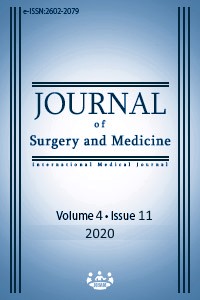Efficacy of caloric vestibular stimulation for the treatment of idiopathic tinnitus
Keywords:
caloric vestibular stimulation, cold, idiopathic tinnitus, neuromodulation, tinnitus handicap inventoryAbstract
Aim: Caloric vestibular stimulation (CVS) induces the activation of several cortical structures and has been utilized as a neuromodulation technique in the treatment of several disorders. This study purposed to investigate whether CVS would be beneficial in the management of idiopathic tinnitus. Methods: Patients with unilateral idiopathic tinnitus were enrolled in the study. CVS with cold water (study group) and body temperature (control group) irrigation were applied to the symptomatic ear. All patients underwent a standard audiometric examination and visual analogue scale (VAS), the tinnitus handicap inventory (THI) and the Beck depression inventory (BDI) were administered. Results: VAS intensity and disturbance values, mean THI and BDI scores did not show any significant changes in the control group. In the study group, a significant improvement in both the tinnitus intensity and disturbance occurred in the first week post-intervention (P<0.001), and a significant decline was observed in median THI and BDI scores as well as the loudness of the tinnitus in the four weeks post-CVS (P<0.001, P<0.001, P=0.004 and P=0.001) respectively). Conclusion: We can conclude that CVS with cold water leads to a significant decline in the intensity of tinnitus and reduction in the loudness of tinnitus, as well as improving THI and BDI scores.
Downloads
References
Savage J, Waddell A. Tinnitus. BMJ Clin Evid. 2014;0506. PMID: 25328113
Knipper M, Van Dijk P, Nunes I, Ruttiger L, Zimmermann U. Advances in the neurobiology of hearing disorders: recent developments regarding the basis of tinnitus and hyperacusis. Progress in neurobiology. 2013;111:17-33.
Riga M, Komis A, Maragoudakis P, Korres G, Ferekidis E, Danielides V. Objective assessment of subjective tinnitus through contralateral suppression of otoacoustic emissions by white noise: effects of frequency, gender, tinnitus bilaterality and age. Acta Otorhinolaryngologica Italica. 2018;38:131.
Langguth B, Elgoyhen AB, Cederroth CR. Therapeutic Approaches to the Treatment of Tinnitus. Annu Rev Pharmacol Toxicol. 2019;59:291-313.
Yuan T, Yadollahpour A, Salgado-Ramírez J, Robles-Camarillo D, Ortega-Palacios R. Transcranial direct current stimulation for the treatment of tinnitus: a review of clinical trials and mechanisms of action. BMC Neurosci. 2018;19:66.
Folmer RL, Theodoroff SM, Casiana L, Shi Y, Griest S, Vachhani J. Repetitive Transcranial Magnetic Stimulation Treatment for Chronic Tinnitus: A Randomized Clinical Trial. JAMA Otolaryngol Head Neck Surg. 2015;141:716-22.
Bottini G, Sterzi R, Paulesu E, Vallar G, Cappa SF, Erminio F, et al. Identification of the central vestibular projections in man: a positron emission tomography activation study. Experimental brain research. 1994;99:164-9.
Miller SM, Ngo TT. Studies of caloric vestibular stimulation: implications for the cognitive neurosciences, the clinical neurosciences and neurophilosophy. Acta neuropsychiatrica. 2007;19:183-203.
Lamprecht J, Morgenstern C. [Bilateral caloric long-term irrigation as a method for the differentiation of tonal tinnitus]. Laryngologie, Rhinologie, Otologie. 1985;64:17-20.
Baguley DM, Knight R, Bradshaw L. Does caloric vestibular stimulation modulate tinnitus? Neurosci Lett. 2011;492:52-4.
Faul F, Erdfelder E, Buchner A, Lang AG. Statistical power analyses using G*Power 3.1: tests for correlation and regression analyses. Behavior research methods. 2009;41:1149-60.
Suzuki M, Kitano H, Ito R, Kitanishi T, Yazawa Y, Ogawa T, et al. Cortical and subcortical vestibular response to caloric stimulation detected by functional magnetic resonance imaging. Brain Res Cogn Brain Res. 2001;12:441-9.
Newman CW, Jacobson GP, Spitzer JB. Development of the Tinnitus Handicap Inventory. Archives of otolaryngology--head & neck surgery. 1996;122:143-8.
Huang C, Chen JH. Meta-Analysis of the Factor Structures of the Beck Depression Inventory-II. Assessment. 2015;22:459-72.
De Ridder D, De Mulder G, Verstraeten E, Van der Kelen K, Sunaert S, Smits M, et al. Primary and secondary auditory cortex stimulation for intractable tinnitus. ORL; journal for oto-rhino-laryngology and its related specialties. 2006;68:48-54; discussion -5.
Norena AJ. An integrative model of tinnitus based on a central gain controlling neural sensitivity. Neuroscience & Biobehavioral Reviews. 2011;35:1089-109.
Vanneste S, De Ridder D. The auditory and non-auditory brain areas involved in tinnitus. An emergent property of multiple parallel overlapping subnetworks. Frontiers in systems neuroscience. 2012;6:31.
Simonetti P, Oiticica J. Tinnitus Neural Mechanisms and Structural Changes in the Brain: The Contribution of Neuroimaging Research. International archives of otorhinolaryngology. 2015;19:259-65.
Marcelli V, Esposito F, Aragri A, Furia T, Riccardi P, Tosetti M, et al. Spatio-temporal pattern of vestibular information processing after brief caloric stimulation. European journal of radiology. 2009;70:312-6.
Bickford PC, Luntz-Leybman V, Freedman R. Auditory sensory gating in the rat hippocampus: modulation by brainstem activity. Brain research. 1993;607:33-8.
Boutros NN, Arfken C, Galderisi S, Warrick J, Pratt G, Iacono W. The status of spectral EEG abnormality as a diagnostic test for schizophrenia. Schizophrenia research. 2008;99:225-37.
Diederen KM, Neggers SF, Daalman K, Blom JD, Goekoop R, Kahn RS, et al. Deactivation of the parahippocampal gyrus preceding auditory hallucinations in schizophrenia. The American journal of psychiatry. 2010;167:427-35.
Vanneste S, Van de Heyning P, De Ridder D. Contralateral parahippocampal gamma-band activity determines noise-like tinnitus laterality: a region of interest analysis. Neuroscience. 2011;199:481-90.
Bense S, Bartenstein P, Lutz S, Stephan T, Schwaiger M, Brandt T, et al. Three determinants of vestibular hemispheric dominance during caloric stimulation: a positron emission tomography study. Annals of the New York Academy of Sciences. 2003;1004:440-5.
Ferre ER, Day BL, Bottini G, Haggard P. How the vestibular system interacts with somatosensory perception: a sham-controlled study with galvanic vestibular stimulation. Neurosci Lett. 2013;550:35-40.
Eggermont JJ. Tinnitus: neurobiological substrates. Drug discovery today. 2005;10:1283-90.
Galazyuk AV, Wenstrup JJ, Hamid MA. Tinnitus and underlying brain mechanisms. Current opinion in otolaryngology & head and neck surgery. 2012;20:409-15.
Leaver AM, Renier L, Chevillet MA, Morgan S, Kim HJ, Rauschecker JP. Dysregulation of limbic and auditory networks in tinnitus. Neuron. 2011;69:33-43.
Downloads
- 858 1213
Published
Issue
Section
How to Cite
License
Copyright (c) 2020 Özlem Saatci, Nesibe Gül Yüksel Aslıer, Özge Arıcı Düz
This work is licensed under a Creative Commons Attribution-NonCommercial-NoDerivatives 4.0 International License.
















